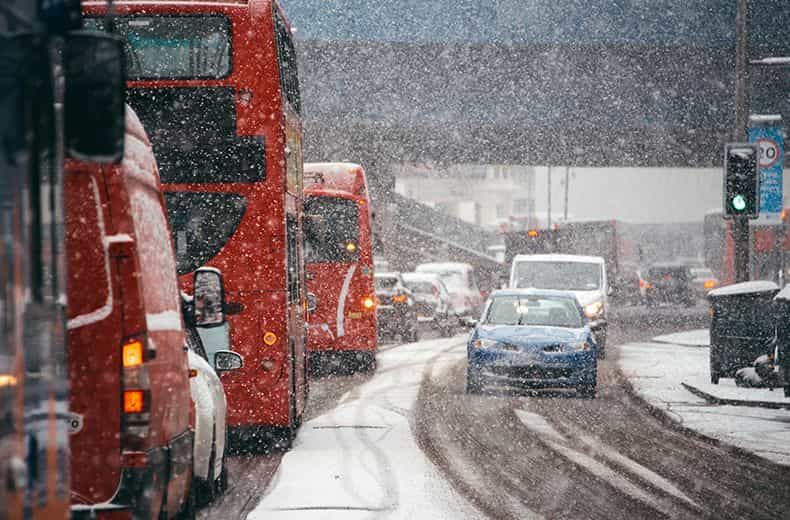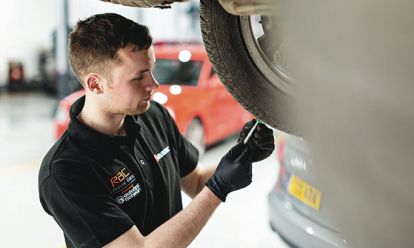If you do need to drive in wintery and snowy conditions then it's worth knowing how to prepare yourself and your car, while also considering different ways to change your driving when faced with these adverse conditions.
The following tips can help make the journey safer.
How to prepare before driving in the snow
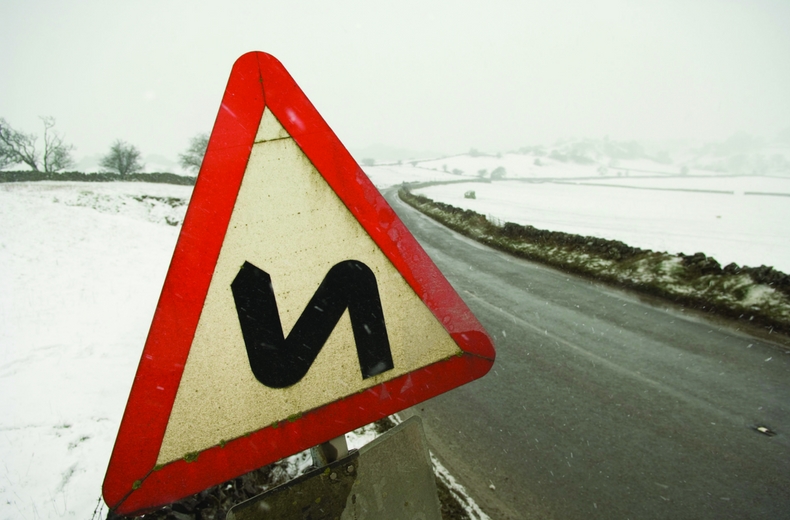
Plan your journey
Before you set off, plan your journey carefully. Use the RAC Route Planner to get updates on traffic news to help make your journey as smooth as possible.
Consider areas that are going to be exposed to the elements, and perhaps prone to flooding. Keep up-to-date with local weather to ensure you aren't caught out.
Give yourself more time for your journey
Allow for more time than you normally would before you leave to clear car windows, mirrors, lights and the top of your roof of snow before setting off, driving with snow on you car could result in you breaking the law.
You will also need to de-ice your windscreen - which is a vital part of winter driving. Pay attention to these tips to keep your windscreen clear.
Knowing how to demist your windscreen in double-quick time can be equally as important.
The following checks will also be time consuming so it is worth factoring them in too before you set off.
Check your windscreen wipers before you start your journey
Make sure any auto wiper control is switched off before turning the ignition on as this could blow the wiper control fuse if they are frozen to the screen. Your wipers need to be in good working order so you’re able to clean your windscreen effectively.
Check your tyres
Check tyres for adequate tread. Poor tyres will not grip when driving on snow and ice.
If you live in an area where snow is common it might be worth changing to winter tyres with deeper tread.
If conditions are really bad you might want to consider the use of snow socks or even snow chains.
Check your screenwash
Use a good quality screenwash that protects down to at least -35 to prevent the water from freezing. If you don’t, your windscreen wipers could be rendered useless in extreme conditions - if you are unsure, you can check and top up your screenwash.
Pack for the worst
Be prepared for every eventuality by ensuring that your car is equipped with the following: demisting pad, torch (wind-up so you don’t run out of battery), a hi-vis vest to make you visible if you break down, a blanket to keep you warm, some food, a drink, spare screenwash, de-icer, ice scraper, blanket, shovel, phone charger, map, a first aid kit, a warning triangle, some jump leads, a spade and a square of carpet that you can use to put under your drive wheels should you get stuck in the snow. Alternatively, you can buy RAC Recovery Track which will get you out of the snow as well as mud and sand.
The most important thing to take with you before driving in snow is a charged mobile phone with the phone number of your breakdown provider stored in it so you can always call for help.

RAC sale – up to 33% off*
• Roadside cover from £5.29 a month†
• We get to most breakdowns in 60 mins or less
• Our patrols fix 4/5 breakdowns on the spot

How to drive in snow
- Wear comfortable and dry footwear
- Accelerate gently, use low revs and change up to a higher gear as quickly as possible
- Move off in second gear as this will help reduce wheel slip - some cars have a winter mode, which does the same job – so to check whether your car has this function in the vehicle’s handbook
- Get your speed right and maintain safe stopping distances between you and the car in front, leaving as much as 10 times the normal recommended gap
- Prepare for an uphill by leaving plenty of room in front so you can maintain a constant speed without the need for changing gear
- Use a low gear for going downhill and try to avoid braking unless necessary, make sure you leave plenty of space between you and the car in front
- When approaching a bend, brake before you actually start to turn the steering wheel. If your car does lose grip try not to panic; the key thing is to take your foot off the accelerator and make sure that your wheels are pointing in the direction you want to go in
- If you do encounter a skid, steer gently into it - for example, if the rear of the car is sliding to the right, steer to the right. Do not take your hands off the steering wheel or stamp your foot on the brakes
- When driving in heavy snow, make sure that you use your dipped headlights. Relying on daytime running lights is not enough, because they don’t always put lights on the back of your car.
- If visibility drops below a 100m, put your fog lights on. But remember to turn them off when the visibility improves.
- If the road has not been gritted, be wary of driving in the wheeltracks or other vehicles as compressed snow is likely to be more icy than fresh snow
- Controls such as the brakes, as well as the steering, accelerator and even gear changing should be operated smoothly and slowly
- Sunglasses can help to reduce the glare of low winter sun on the snow
- Keep your speed down and allow more time to stop and steer
- Finally, it’s important to think about the environment that you’re driving in, especially microclimates that might appear on the road. These are areas that perhaps the sun hasn’t got to, which could stay icy when the rest of the road has thawed. Bridges are a good example. They’re normally the first to freeze and the last to thaw. So be aware of that when you’re driving in open spaces.
Make sure you keep your car clean. The salt used to de-ice roads can cause corrosion to your car over time, so it’s worth making a point of cleaning it regularly throughout the winter months.
Winter tyres, snow socks or snow chains?
Each of these products will help you tackle the snowy elements, but which should you buy to best suit your driving needs?
Winter tyres
- These are alternatives to the standard summer tyres that most cars are fitted with and offer more grip in adverse weather conditions such as rain, ice and snow
- They significantly improve a car's performance in these conditions but may not be able to tackle very deep snow
- They are not a legal requirement in England like they are in some countries but are recommended for those who live in more remote areas which are more heavily and more regularly affected by adverse weather conditions
- It is important to check if you need winter tyres in your area
Snow socks
- Snow socks offer more grip on snow and are useful to have in your boot in case you need to drive in:
- Unexpected snow - for instance when taking a back road that hasn't been cleared of snow
- Tackling a snowed in driveway
- They are a cheaper alternative to winter tyres but must be removed when the road is clear again
- They are easier to fit then snow chains are not suitable for very deep snow
Snow chains
- Snow chains offer the best grip in snowy conditions
- They are best suited for deeper snow
- They must be removed when snow clears or when driving on a clear road as they could damage your car and the road
- They are more time consuming to fit than socks
- They are a mandatory requirement in some countries
Snow chains
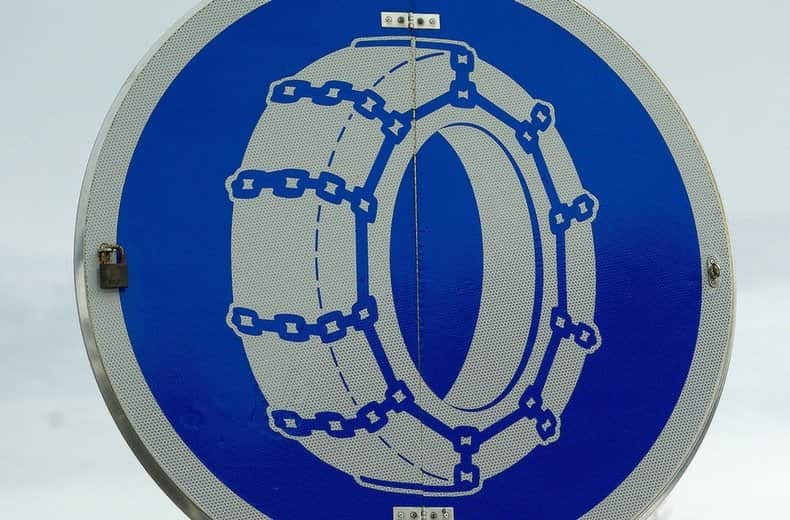
Should I use snow chains?
Snow chains must only be used on a layer of compacted snow and should be removed once you reach a clear section of road. You risk damaging your car and the road if you ignore this advice, double check this info when purchasing your snow chains.
In some European countries, carrying a set of snow chains in the boot is a mandatory requirement, which is worth considering if you’re planning a skiing holiday. Driving abroad in winter presents its own challenges. Normally these countries sign post (below) when snow chains are a legal requirement.
In the UK, the opportunities to use snow chains might be few and far between, but that doesn’t mean they don’t have their uses.
In the more remote and hilly regions of the country, where the roads might not be treated, fitting snow chains could be the difference between getting home and being left stranded at the roadside.
How to fit snow chains
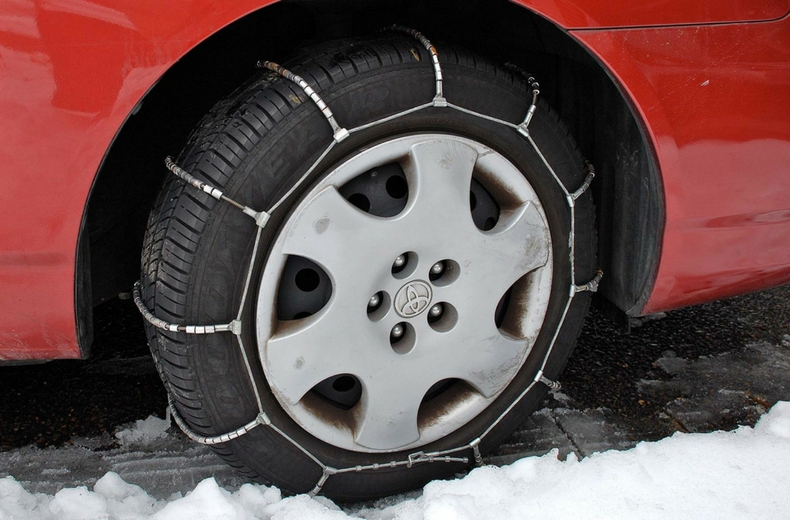
Chains should not be fitted if there is not enough clearance between the wheel arch and tyre.
If your tyres are equipped with electronic sensors, poorly fitted chains can also interfere with them.
Where chains can’t be fitted, it may be worth considering a second set of wheels that can accommodate them.
The first thing to do when fitting snow chains is to check your vehicle’s handbook to ensure your car can be fitted with them, most cars are perfectly suitable.
Before you start
We’d recommend wearing gloves, as oil and brake dust on your expensive skiwear won’t be a good look on the slopes. Using a high-viz jacket is also a good idea.
A step by step guide to fitting snow chains
- Fitting snow chains is a job that can be done by one person.
- Remove the snow chains from the packaging and lay them out on the ground, removing any twists.
- You’ll also need to ensure the chain hooks are facing away from the tyre.
- If the chains have a cam-tensioning device, make sure this is on the outside of the tyre.
- If it’s a front-wheel drive car, use a pair of chains on the front wheels.
- If it’s rear-wheel drive, fit the chains to the rear wheels.
- If you’re driving a four-wheel drive vehicle, then in the majority of cases, you should fit snow chains to all four wheels. Check your vehicle’s handbook or consult your local dealer if you’re uncertain.
- Put the car in gear and apply the handbrake, then turn the engine off.
- This is a safety measure to ensure the car doesn’t roll back and forth as you work around the wheels.
- The first job is to position the chains behind the wheel.
- This is done by passing the bright plastic-covered part of the chain around the driven wheel: feed it along the ground behind the wheel, working from the back to front of the car.
- Then, take both ends of the chain and lift it to the top of tyre: join the ends of the plastic-covered chain together and attach, before draping the chain over the entire wheel and tyre.
- Pull the loose links around the edge of the wheels, using the connecting link to fasten the upper section.
- Ease the link over the back of the tyre.
- Then, pull the long loose length tight and pass it through the tensioning ratchet at the bottom of the wheel.
- Pull tight before hooking up the slack chain.
- Drive forward a few yards, then release the chain and give it a good tug.
- This is an important stage: it will take up any slack that may have emerged as the chain settled on the tyre as the wheel rotated.
- Re-tension by tidying up the loose chain and you’re good to go.
- It’s a simple process and – with some practice – you can fit snow chains to a single wheel in under two minutes.
How to remove snow chains
To remove the snow chains, make sure the car is in gear, the handbrake on and the engine off, and follow the same steps but in reverse order.
Lay the chain on the floor to remove any snow or twists, before storing them in the packaging.
Remember, not all snow chains are created equal, and some will feature different components and require a different method of fitting and tensioning. Consult the packaging for more information.
For more specific advice we’d recommend consulting the packaging or the retailer who sold the snow chains.
How to drive with snow chains on
When it comes to driving with snow chains fitted, the best advice is ‘smoothly does it’.
Accelerate and decelerate gently, and do not travel at speeds in excess of 30mph. It’s probably best to switch off the traction control, but your handbook will provide clear instructions for your car.
Snow socks
What are snow socks?
Snow socks are textile liners for the wheel and tyres and are – generally speaking – a good alternative to traditional snow chains.
They’re designed to be a snug fit, covering the tyres and acting as an extra layer between them and the snow to increase grip and traction.
One major advantage of snow socks is they are much easier to fit than standard snow chains. They’re also quieter and won’t ruin the ride quality in the same way as a set of snow chains might.
On the flip-side, they might not be suitable for harsh conditions and aren’t recommended for use on roads where the use of snow chains is compulsory.
When should I use snow socks?
Snow socks are ideal for the unpredictable nature of the great British weather.
They might not be suitable for the harshest conditions like snow chains and aren’t recommended for use on roads where the use of snow chains is compulsory (like in some European countries) but when the snow starts to fall in Britain they are great to have in the boot of the car to get you out of a sticky spot.
They are particularly helpful for quickly getting off a snow-laden driveway, or if you anticipate a road which hasn't been cleared of snow.
They normally prove their worth when you aren't expecting snowfall and perhaps need to head home after a sudden period of snowfall.
They should be used only on areas where there is snow and must be removed when driving on snow-clear roads.
How to fit snow socks
Snow socks are much easier to fit than snow chains.
They are available in a variety of different sizes and you’ll need to find the right set for your car, you can check your sidewalls for the size of tyre on your car to match the corresponding sock size.
Steps to fit snow socks
- You have to fit the snow socks to the driven wheels of the car
- While the handbrake of the car is on starting at the top of the wheel and pull the sock down to cover the whole tyre
- Drive the car forward so that the section of sock previously at the top of the tyre is now at the bottom, which will allow you fit the remaining section
Snow socks won’t turn your car into a winter rally hero, so drive within your limits and according to the conditions. Remove the socks when you reach clear roads.
For more information on snow chains or snow socks, turn to your vehicle’s handbook or consult your local dealer. Make sure you have RAC breakdown cover, van breakdown cover or business breakdown cover too. Safe driving!
Check out our Winter Driving Range on the RAC Shop.
Driving safely in snow - FAQs
- How should you drive in snow?
You will need to gently accelerate the vehicle using low revs and shift to a higher gear as quickly as possible. To keep yourself and other road users safe, keep drive well below the speed limit and be very aware of all your surroundings. Anticipation is key. Give yourself enough time to maintain a safe braking distance. Try and avoid steep incline or declines, but when climbing a slope, keep a healthy distance between you and other vehicles. If safe to do so, always brake gently.
If your vehicle starts to lose grip on a turn, slow down and keep your wheels pointing in the direction you want to travel in until you stop or are safe to increase speed. Never take your hands of the steering wheel.Also, keep your headlights on at all times - just not full beams.
- Should you drive in low or high gear in snow?
Always drive in higher gear with lower revs when driving in snow. Keep your speed low as well and keep a healthy distance between you and other road users.
- Do I turn traction control off in snow?
You should always keep traction control on in your vehicle if you are driving in snowy or icy conditions. However, if you get stuck, then turn it off until you have freed your vehicle.
- What mode is best to drive in snow?
Many modern vehicles have a ‘Snow’ or ‘Ice’ mode - where the in-built technology sets the vehicle up for optimum driving in those conditions. If your vehicle doesn’t have these option, keep traction control on, drive in a higher gear and with low revs.

